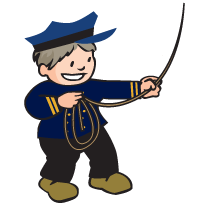Boston Children's Museum
308 Congress Street, Boston, MA 02210
617-426-6500
© Boston Children’s Museum 2025
Website Design by JackrabbitStorytelling encourages creative writing and practice of written language. It also helps children learn how to write clear sentences that develop a central idea, and how to be thoughtful about the audience and purpose of written material. And because this activity requires teamwork, children will have to clearly describe their ideas and synthesize them with their peers’ thoughts. This activity also gives children a chance to practice specific vocabulary, brainstorming and writing dialogue.
Make sure that you have played Captain’s Coming before doing this activity. Gather as many materials as possible for making costumes and props.

Ask your students if they remember the terms that they learned in Captain’s Coming. What do they think it was like to live as a sailor a long time ago? What do they think it is like now?
Can you write a short play about life on the sea?
After teams have been writing for about 10 minutes, gather everyone together to talk about their process so far. What has been hard about creating their play? What has been easy? Have they come up with their basic story line? How about the names of their characters? Are all of their characters people, or are some animals or things? Where is their story set (on a ship, on an island, etc.)? When does their story take place (is it recent, does it take place a long time ago, etc.)? There are many questions that teams will need to consider—but don’t expect teams to have all of these questions answered yet. Just make sure to bring them up.
Have teams return to their plays to complete them. When their stories are done, you have several options: